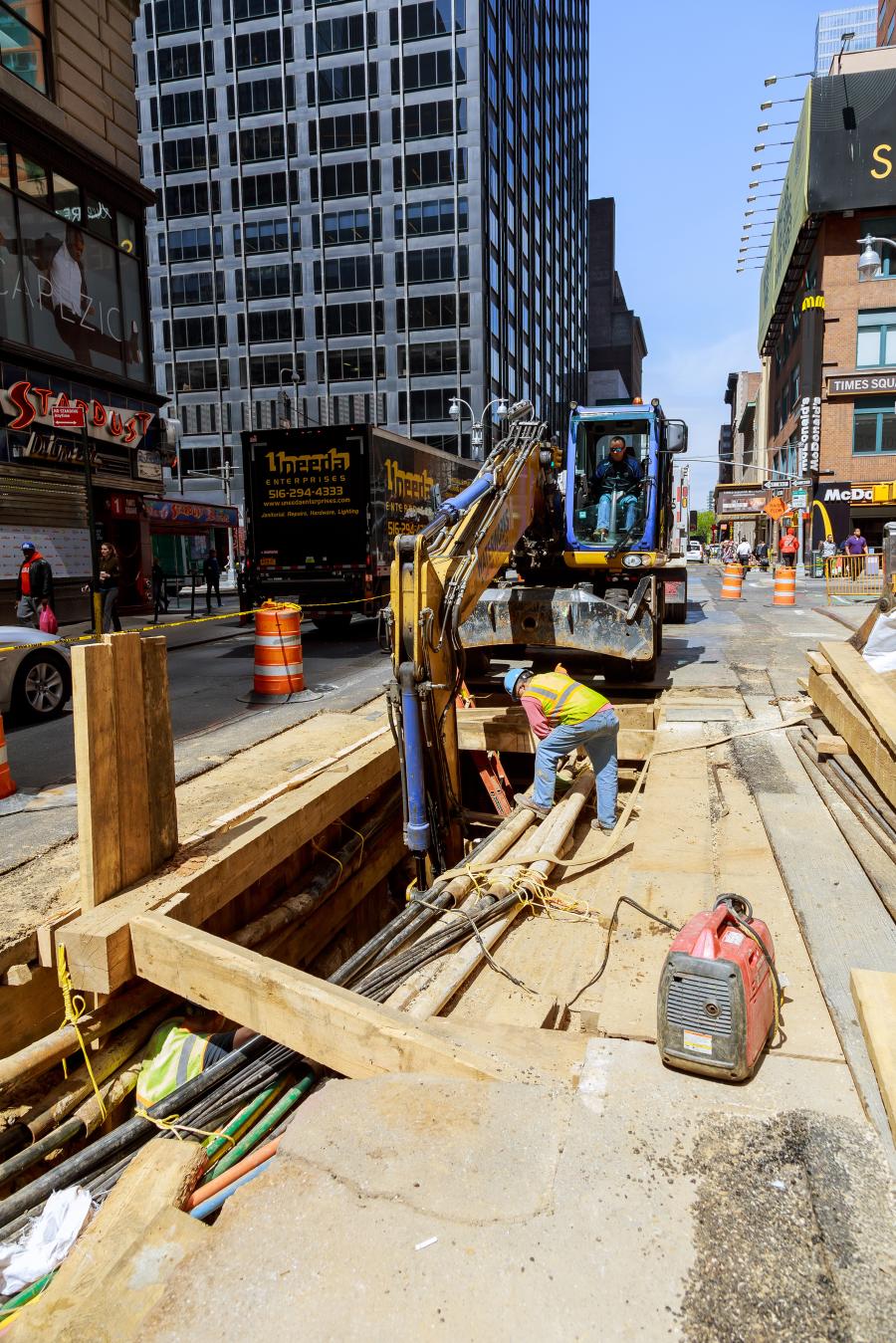Construction employment rose by 60,000 jobs between January and February, and hourly pay jumped its highest in nearly 40 years.
The first two months of 2022 saw a sizable increase in payroll numbers in the construction industry. The AGC reports employment rose by 60,000 jobs between January and February, and hourly pay jumped its highest in nearly 40 years. The industry still faces a massive worker shortage, but good-paying jobs have people migrating into construction, choosing craft trades over desk jobs.
"All segments of construction added workers in February," said Ken Simonson, AGC's chief economist. "However, filling positions remains a struggle, as pay is rising even faster in other sectors."
In fact, the average hourly wage for construction craft workers increased 6 percent from February 2021 to February 2022. Simonson noted it was the steepest 12-month increase since December 1982.
He also noted that the industry average of $31.62 per hour for such workers exceeded the private sector average by 17 percent.
Employment numbers at construction firms of all types saw an increase in February. Nonresidential added 29,400 employees, including 19,900 more employees among specialty trade contractors, 7,300 at heavy and civil engineering construction firms and 2,200 working for general building contractors.
In comparison, employment in residential construction rose by 31,000 workers. Among those numbers, 24,300 joined specialty trade contractors and 6,700 were employed by homebuilders and multifamily general contractors.
The number of unemployed jobseekers with construction experience shrank by 26 percent over the past year, according to Simonson's report, from February 2021 to 677,000 in February 2022.
He said the decline shows the industry will have a hard time filling positions with experienced workers.
Association officials believe the industry will need to hire hundreds of thousands of additional workers annually for the next several years to both finish projects funded by the bipartisan infrastructure law and satisfy the continuing demand for homebuilding and private nonresidential structures.
AGC officials are pushing for increased funding for career and technical education and to support a wider range of apprenticeship and training opportunities and to enable further pursuit of high-paying construction careers.
"Construction firms are doing all they can to add employees and pay them well," said Stephen E. Sandherr, CEO of the AGC. "But there are not likely to be enough workers to meet demand unless officials in Washington act now to prepare more jobseekers for these opportunities."
In fact, the Associated Builders and Contractors predicts the industry will need to draw nearly 650,000 additional workers this year to meet the demand for labor.
"ABC's 2022 workforce shortage analysis sends a message loud and clear: The construction industry desperately needs qualified, skilled craft professionals to build America," said Michael Bellaman, president and CEO. "The Infrastructure Investment and Jobs Act passed in November and stimulus from Covid-19 relief will pump billions in new spending into our nation's most critical infrastructure. Qualified craft professionals are essential to efficiently modernize roads, bridges, energy production and other projects across the country. More regulations and less worker freedom make it harder to fill these jobs."
ABC's proprietary model converts anticipated increases in construction outlays into demand for construction labor at a rate of approximately 3,900 new jobs per billion dollars of additional construction spending.
This increased demand is added to the current level of above-average job openings. Projected industry retirements, shifts to other industries and other forms of anticipated separation also are factored in.
Based on historical Census Bureau Job-to-Job flow data, an estimated 1.2 million construction workers will leave their jobs to work in other industries in 2022. It is expected that this will be offset by an anticipated 1.3 million workers who will leave other industries to work in construction, predicts ABC.
"The workforce shortage is the most acute challenge facing the construction industry despite sluggish spending growth," said Anirban Basu, ABC chief economist.
After accounting for inflation, construction spending has likely fallen over the past 12 months, Basu said. As outlays from the infrastructure bill increase, construction spending will expand. This in turn will exacerbate the chasm between supply and demand for labor.
"An added concern is the decline in the number of construction workers ages 25 to 54, which fell 8 percent over the past decade. Meanwhile, the share of older workers exiting the workforce soared," he continued.
According to the CDC, the industry's average age of retirement is 61, and more than one in five construction workers are currently older than 55, said Basu.
"The scarcity of qualified skilled workers is an even more pressing issue," Basu said. "Since 2011, the number of entry-level construction laborers has increased 72.8 percent, while the number of total construction workers is up just 24.7 percent."
For reference, he said the number of electricians was up 23.9 percent over that span while the number of carpenters actually declined 7.5 percent. The number of construction managers has increased by just 2.1 percent, according to Basu's figures.
More than 40 percent of construction workforce growth over the past decade consists of low-skilled construction laborers, who represent just 19 percent of the workforce.
"The roughly 650,000 workers needed must quickly acquire specialized skills," said Basu. "With many industries outside of construction also competing for increasingly scarce labor, the industry must take drastic steps to ensure future workforce demands are met."
In 2023, the industry will need to bring in nearly 590,000 new workers on top of normal hiring to meet industry demand, and that's presuming that construction spending growth slows next year.
"Now is the time to consider a career in construction," said Bellaman. "The vocation offers competitive wages and many opportunities to both begin and advance in an industry that builds the places where we work, play, worship, learn and heal."
The Allure of Craft Trades
It seems America's workers are listening. Millions, part of the Great Resignation, are leaving jobs during the pandemic and embarking on new careers in construction.
As the shift unfolds across the country, the migration has spurred an interest in trade schools across the country, according to radio station wbur.com.
Some say they are fleeing toxic workplaces while others seek better pay or benefits. Many want radically new ways to work.
At the same time, fewer high-school grads are considering four-year colleges. Data from the National Student Clearinghouse shows an enrollment increase in two-year construction programs.
The pandemic has meant more students opting to go into the trades, according to wbur.com.
And the interest in craft trades could accelerate with the IIJA plan, which should boost demand even further for construction workers across the country.
Many of the new workers are likely to come from vocational and technical schools, which typically train people for trades like electrical work or auto repair.
Tony Carnevale, head of the Georgetown University Center on Education and the Workforce, believes the labor shortage can be fixed by two things: immigration and workforce training. Good-paying jobs help, too.
Money Talks, Workers Walk
In his Jan. 31, 2022, Data Digest edition, the AGC's Simonson included Bureau of Labor Statistics numbers for construction wages and salaries. The two rose 1.3 percent in the fourth quarter of 2021, and 3.8 percent year-over-year.
Those figures are up from 2.8 percent in 2020. In comparison, wages for the total private sector accelerated to a 5-percent y/y increase, which is the most in the 21-year history of the series.
Compensation in construction, including wages, salaries and benefits, rose 1.1 percent in Q4 of 2021 and 3.5 percent year-over-year, up from 2.4 percent in 2020.
Total private industry compensation increased 1.2 percent in Q4 and 4.4 percent year-over-year, up from 2.6 percent in 2020, according to Simonson.
The steeper increases in sectors other than construction may be one reason contractors are having trouble filling jobs, he said.
A construction industry survey conducted by the National Center for Construction Education and Research (NCCER) echoed data showing skilled craft professionals continue to earn high wages.
NCCER's 2022 Construction Craft Salary Survey found that of the 41 construction positions surveyed, average annual salaries ranged from $49,920 to $98,965.
Project supervisors and project managers topped the list, earning more than $90,200 and $98,900, respectively.
Professions earning more than $65,000 include HVAC technician, commercial electrician, instrumentation fitter, boilermaker, industrial maintenance mechanic, pipefitter, rigger, millwright, industrial electrician, pipe welder, surveyor, construction site safety technician, electronic systems technician, mobile crane operator, plumber, combo welder, tower crane operator, instrumentation technician and power line worker. Eight other craft areas made more than $60,000 per year.
The most significant pay increase was power line worker, up 25 percent from previous years, with plumber a close second at a 23 percent increase.
Because many craft professionals receive additional pay incentives, their take-home pay is typically much greater than the incomes reflected, according to NCCER.
In fact, construction worker pay grew at the fastest rate in 40 years, according to BLS numbers.
"Average hourly earnings in construction are up 6 percent on a year-over-year basis in February, the fastest pace since 1982," Odeta Kushi, deputy chief economist of First American, told Business Insider. "The rise is positive news for an industry that has been grappling with chronic labor shortages. In such a labor-intensive industry, you need more workers."
The National Association of Home Builders noted that subcontractor shortages are even more widespread than "shortages of labor employed directly by general contractors.
"Attracting skilled labor will remain a key objective for construction firms in the coming quarters and will become more challenging as the labor market strengthens and the unemployment rate declines," NAHB maintains. CEG
Lucy Perry
Lucy Perry has 30 years of experience covering the U.S. construction industry. She has served as Editor of paving and lifting magazines, and has created content for many national and international construction trade publications. A native of Baton Rouge, Louisiana, she has a Journalism degree from Louisiana State University, and is an avid fan of all LSU sports. She resides in Kansas City, Missouri, with her husband, who has turned her into a major fan of the NFL Kansas City Chiefs. When she's not chasing after Lucy, their dachshund, Lucy likes to create mixed-media art.
Read more from Lucy Perry here.
Today's top stories


















